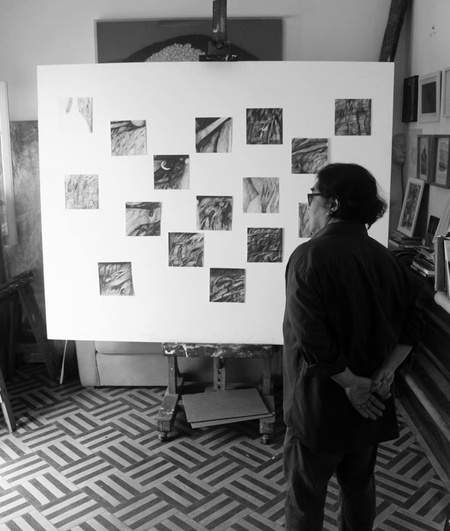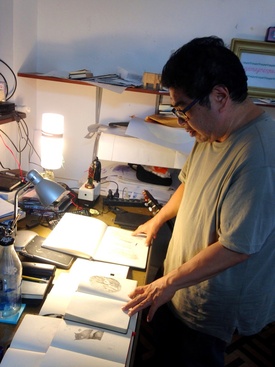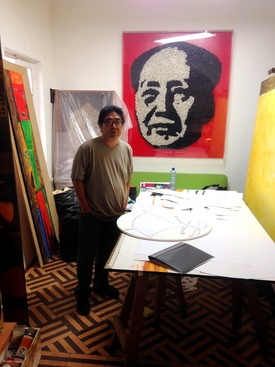His gaze conceals a reality that he has transformed into art. Eduardo Tokeshi, born in Lima in 1960, emanates a sense of imperturbable calm that he’s maintained from the time he began exhibiting his first works and walked around with long hair, and even on this particular afternoon when the weather seems to have come to a standstill in his home studio in Miraflores.
At 55, Tokeshi has been working as an artist for almost three decades. Yet his work, which has been exhibited in around 20 countries, seems like that of a young talent. Since a retrospective of his work was organized four years ago, the artist has entered a new period which he undertakes with an enthusiastic lucidity. “I’m younger now than when I was 30 years old,” he says.
In his studio, where a color palette appears to have been left aside without regret, the artist repeats some statements he’s made in other interviews: that he was born in an “Okinawa” in Lima’s downtown, that he feels as Peruvian as ceviche, that he spends more time reading and watching films than painting, that becoming a father changed
his life, and that he is now in a stage of his life in which he wants to communicate through drawing.
Graphic Diary
With El pequeño Hokusai (Little Hokusai) and later with El gran dibujo (the Big Drawing), Eduardo Tokeshi demonstrated a renewed interest in pencil and black ink drawings, which he considers the original language. “Drawing is the architecture of an idea. I don’t think you can be a good painter if you’re not good at drawing,” he says, showing me a stack of notebooks he’s filling with work in black ink that will be part of his next show in Lima, along with Nikkei artist Aldo Shiroma, and part of his next book.

Photo: Author’s personal archives.
A huaco, echoing Peru’s characteristic pre-Columbian ceramic vessels but in the form of Darth Vader, villain of the movie Star Wars; Death resting in a forest clearing; Little Red Riding Hood dressed in a wolf’s hide; and a series about petroleum pollution based on a recent environmental tragedy in the Peruvian jungle are all part of what resemble graphic diaries.
In fact, the first drawings are grouped together under the name San Antonio Notebooks, an allusion to the Miraflores café where Tokeshi used to eat breakfast and where this saga inspired by Japanese comics and graphic novels was born. It could already be seen in Little Hokusai with its bear-wolf characters (but in full color) and other elements that reveal a playful and poetic point of view. “Drawing is the freedom in the simple and the baroque.”
The Art of Looking

Photo: Author’s personal archives.
Two extreme figures sit on Eduardo Tokeshi’s work table. One is a small statue of St. Jude, patron saint of lost causes, with a hatchet in his hand. A Darth Vader toy stalks him with his lightsaber. Since the period in which Tokeshi painted tableaus, he created a Peruvian flag out of bags of blood and refashioned jackets, the art of this Nikkei artist has been unsettling.
For some time many viewed his work as political, while others saw it as an investigation of the artist’s identity. “The work with flags was perhaps symptomatic,” he explains, “[of] a desire to search, to belong.” His Okinawan parents inculcated him with Shintoism as well as Western religion and traveled to Japan, all of which has influenced his work.
“They spoke Japanese to each other but didn’t teach us the language,” he says. That secretive attitude awoke in him a curiosity that Tokeshi has transformed into a career as a painter (“art that doesn’t need words”) and which he attempts to transmit to his students at the Pontifical Catholic University of Peru.
“I have this compulsion to share. In class, I don’t teach them to paint; I try to give them tools for curiosity. What is most interesting to me is being able to share, to teach the feeling of a bolero, for example, or finding the quality in a B-horror movie. You don’t teach people painting; you teach people how to observe.”
Nikkei Identity

Photo: Javier García Wong Kit.
In a certain way, many Nikkei share customs, beliefs, and ways of being that identify them as part of a group. In his studio, packed with paintings, films, books, work materials, and a guitar, Eduardo Tokeshi acknowledges that his Japanese side lies in his “personal” bushido for working: an Eastern perfectionism mixed with other codes and experiences.
“I wouldn’t be who I am without those two currents,” he says, recalling the “mobile” Okinawa of his childhood home but also the history of Peru he inherited from having grown up there: “The history of the Incas, the wars, the failures, the songs.” Looking different, being Nikkei, have allowed him to highlight certain things that have served his work.
“I lived in Lima and studied in La Victoria, where there were many Nikkei. We studied together. We were a kind of an enclave but at the same time I grew up praying novenas and revering Father Urraca, who I believe in,” he says, referring to the monk who once lived in central Lima, where he was hounded by demons, and ultimately several miracles were attributed to him.
“I learned that when my grandmother had bad dreams in which something happened to her grandchildren, she brought in the Japanese healer (yutá). She made us remove our clothes so she could put scissors on our backs while murmuring something in an unintelligible dialect. After the healer left, my grandmother would bring in the priest from the orphanage to sprinkle us with holy water; that way she covered everything,” he wrote in a column published in Vela Verde magazine.
Older Youth
Times have changed in Eduardo Tokeshi’s home studio. “Last year I experienced my first problems of old age: high blood pressure and cholesterol,” he says before sharing an anecdote from these times of technology and social media. The artist has published many of his drawings on Facebook and Instagram, showing his side as a children’s book illustrator, book cover artist, caricaturist, and comic artist.
This more “pop” side of the artist has attracted new audiences. Young adults and adolescents from around the world ask him to draw with them, bolstering this artist’s career, without knowing that he has shown his work almost everywhere in Latin America, as well as Italy, France, Germany, Holland, Japan, Canada, and the United States, where he will return this year to participate in a show at the Japanese American National Museum.
This is also a new time for Tokeshi, who is addicted to Netflix and keeps his comic books alongside those of his son Martín, who also draws. He stays young in large part because of his curiosity. “When something bores me, it’s a sign that I need to go in another direction,” says this eternal adolescent who isn’t afraid to admit that he’s influenced by everything. “People who say the morning news shows don’t influence them are lying,” he says, standing before a flat screen that hangs, like a painting, above his work table.
* Eduardo Tokeshi has been working as an artist for almost 30 years, and as he says, he feels younger now than when he was young. His black ink drawings reflect an artist who transforms the simplest art form into the most profound form of expression.
© 2016 Javier Garcia Wong-Kit






